Living with a brain injury?
Take our quick check and find answers
INTRODUCTION
What is a traumatic brain injury (TBI)?
Our brains are incredibly adaptable organs, constantly learning and forming new connections. However, a traumatic brain injury (TBI) can disrupt these delicate pathways, impacting memory, focus, and overall cognitive function.
Brain injuries can occur from a variety of situations, including falls, motor vehicle crashes, assaults, sports injuries, shaken baby syndrome, medical procedures, and explosions.
While traditional rehabilitation remains the cornerstone of TBI recovery, light therapy is emerging as a potential approach to address some of the challenges faced by individuals with brain injuries, such as sleep difficulties, chronic fatigue, energy levels, and improving overall cognitive function. [1]

Symptoms Linked with TBI
- Difficulty remembering recent events, conversations, or struggles to learn new things;
- Frequent headaches, lightheadedness, or feeling off-balance;
- Difficulty focusing or staying on task for extended periods;
- Trouble finding words or expressing yourself clearly;
- Feeling disoriented, forgetting where you are, or having trouble recognizing familiar faces;
- Feeling excessively tired or experiencing disrupted sleep patterns;
- More frequent feelings of frustration, anger, or sadness;
- Difficulty maintaining balance or experiencing clumsiness.
How It Works?
Protecting Yourself After a TBI
Light therapy effectively targets the right prefrontal cortex, which plays a crucial role in many cognitive functions, such as emotional regulation, decision-making, problem-solving, social cognition, and spatial awareness.
Damage to this area can have significant consequences, which often happens in individuals suffering from TBIs (traumatic brain injury).
How often do I need to use light therapy?
Most people can experience improvements with our light therapy device after just a few minutes of usage daily. It's like a vitamin that should be used every day for that boost!
How to know if light therapy is for me?
While traditional medical treatments remain the cornerstone of TBI recovery, light therapy is emerging as a potential approach to address some of the challenges faced by individuals with brain injuries.
Light therapy has shown promise in regulating the body's natural sleep-wake cycle (circadian rhythm) so it can be an option if you’re struggling with disrupted sleep patterns.
Research also suggests light therapy may improve energy levels by boosting cellular function and mitochondrial activity, which can help with chronic fatigue, as well as benefit areas like executive function (inhibition and switching abilities), memory (learning and recall), PTSD symptoms, and daily living abilities [2]
A study by Chao, L. et al. (2020) discusses a case study of a professional hockey player who had a history of concussions and experienced headaches, anxiety, and difficulty concentrating. After 8 weeks of light therapy treatment, the player showed positive changes in brain volumes, functional connectivity, cerebral perfusion, and neuropsychological test scores. [3]
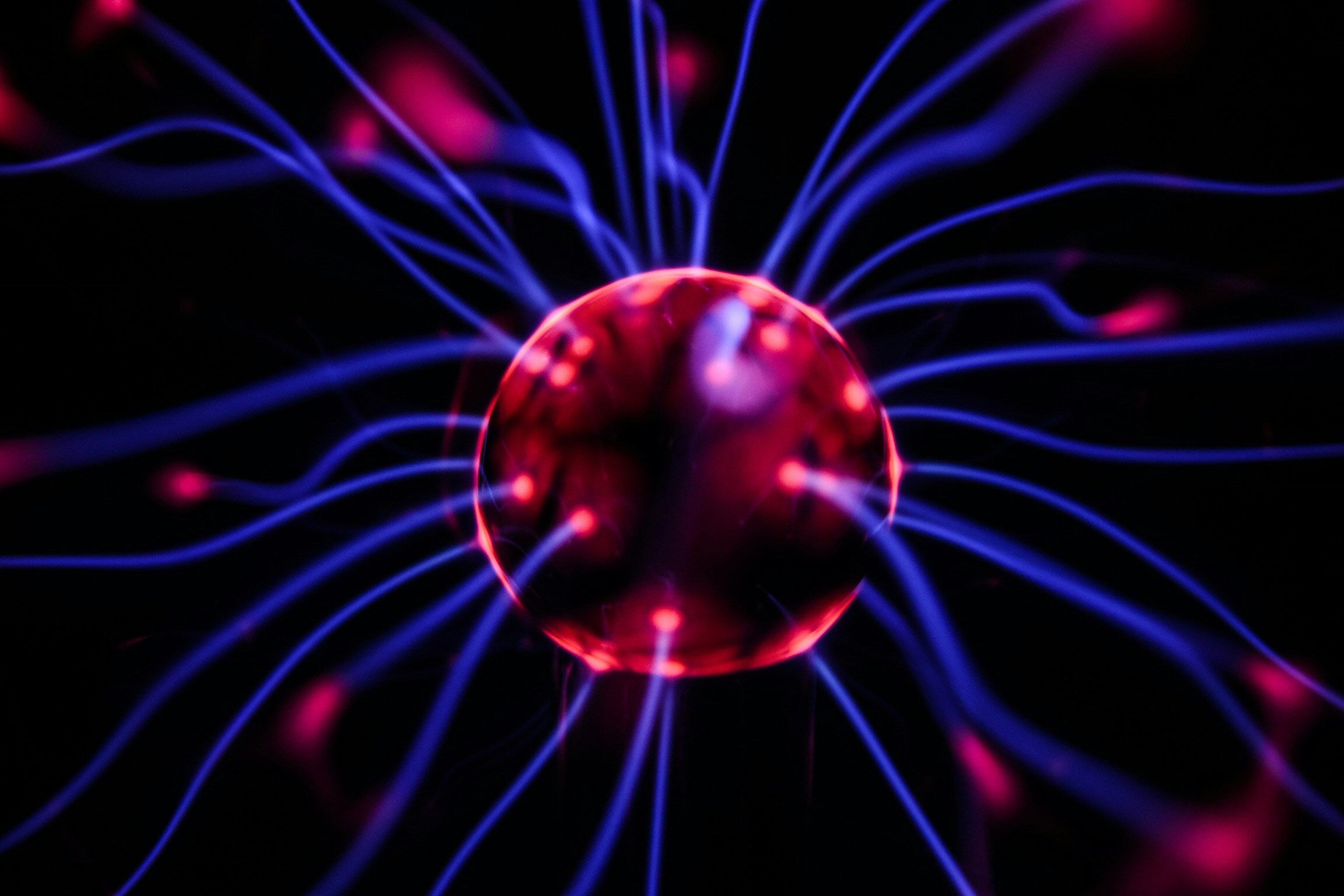
Our light therapy device
Neuradiant 1070
The Neuradiant 1070 by Neuronic is a brain light therapy device that comes with 4 pre-set programs for everyday use or advanced options to customize the time, pulse rate and intensity over 4 different brain quadrants. A 30-minute complimentary session with one of the Neuronic internal consultants is included with the purchase to learn how to use it the best.
While the pre-set protocols included in the Neuradiant 1070 are easy to use and provide benefits of light therapy through 4 different settings, we also offer a 3-month consultation that includes custom-designed protocols based on Quantitative EEG (qEEG) results and personal history that can greatly enhance the functional benefits of photobiomodulation (PBM).

Following multiple concussions in his MMA career,
UFC legend Gray Maynard shares his experience
with the Neuradiant 1070
“I’ve been sleeping better and I’m more focused in life, I can’t thank Neuronic enough
for the enhanced clarity and focus to help me achieve my goals”
Learn more about it here.
Check what others say about the Neuradiant 1070:
"My memory improved to better than normal after just 2 weeks!"
- Jennifer Alexander
"Since using the Neuradiant 1070, I have noticed a surprisingly marked improvement in my recall"
- Joe Rose
"Our daughter suffered a TBI in 2005. Now we are seeing more of her personality, she is more engaging, and takes a bigger part in conversations"
- Troy Brown
Safe. With no known side effects.
Embrace a safe, simple, and side-effect-free approach to boost your cognitive function.
Pre-Post Neuradiant 1070 Usage Test
Results for the paired t-test comparisons, pre- versus post-testing after 12 treatments, for each cognitive test for Group 1 (tPBM), and for Group 2 (wbPMB) are presented separately. [4]
For Group 1, each cognitive test showed significant improvement ( p < 0.05 or beyond), except for PRT.
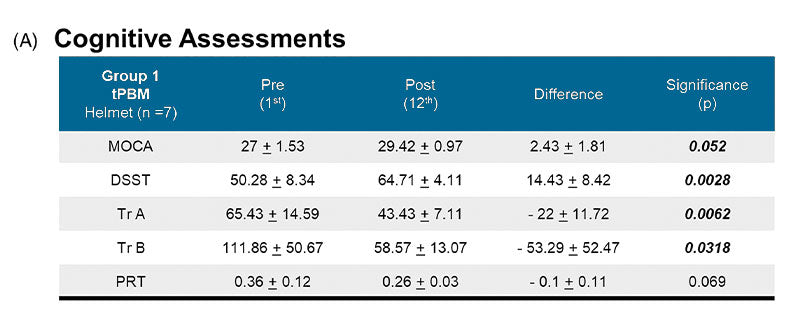
For Group 2, each cognitive test also showed significant improvement ( p < 0.05 or beyond), except for TrA and PRT.
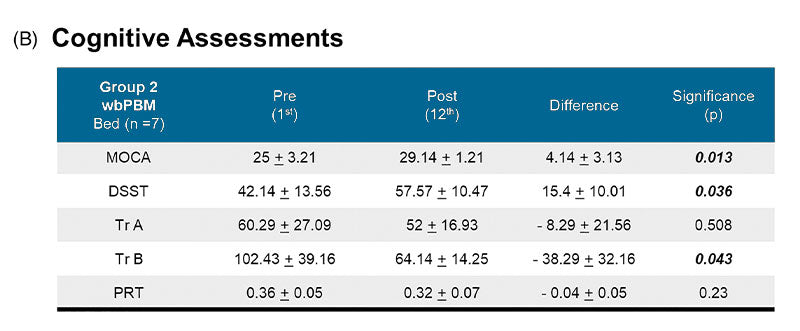
The individual results are discussed below.

MoCA
The Montreal Cognitive Assessment (MoCA) is a test used to detect mild cognitive decline and early signs of dementia. It can help identify people at risk of Alzheimer's disease and screen for conditions like Parkinson's disease, brain tumors, substance abuse, and head trauma.
Graph C shows the pre and post light therapy protocols. In both groups we see an increase in the MoCA score, with a higher score meaning less impaired cognitive function.
DSST
Digit symbol substitution test (DSST) is a neuropsychological test sensitive to brain damage, dementia, age and depression. The test is not sensitive to the location of brain-damage (except for damage comprising part of the visual field).
Additionally we can see in the DSST there is also an increase from the baseline test to after the light therapy was applied.
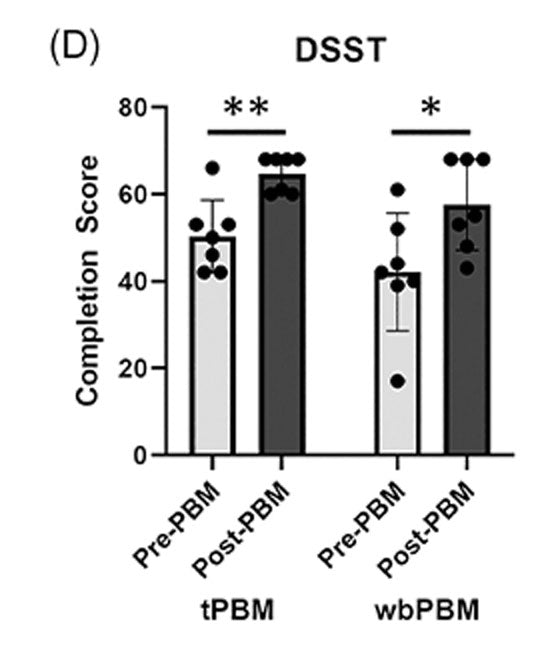

Trail A
The Trail Making Test, Part A (TMT-A) is a neuropsychological test used to assess visual attention, processing speed, and mental flexibility. It involves connecting a sequence of numbers as quickly as possible in ascending order. The score is based on the time taken to complete the task, with shorter times indicating better performance.
The graph E shares a clear indication that after patients received the transcranial light therapy in particular there was a reduction in time it took to complete the task, showing clear cognitive processing improvements.
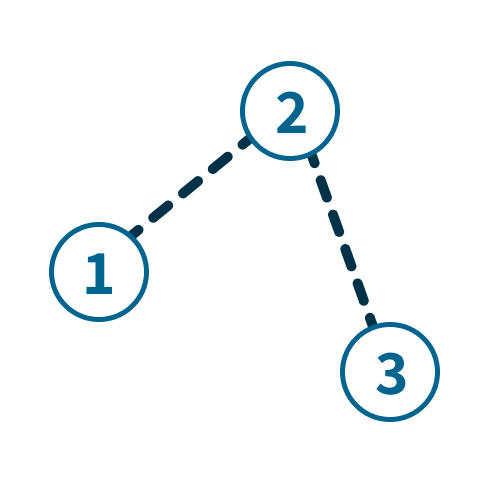
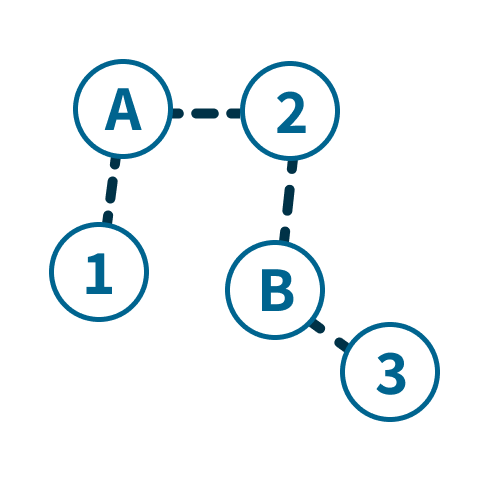
Trail B
Part B (TMT-B) requires participants to alternate between numbers and letters in ascending order (e.g., 1-A-2-B-3-C, etc.). Completion time is recorded, with longer times indicating potential difficulties in mental flexibility and executive function.
The second test in graph F shares also a reduction in the time it took to take the test. Notably after patients used the light therapy helmet the time was reduced nearly 50%.
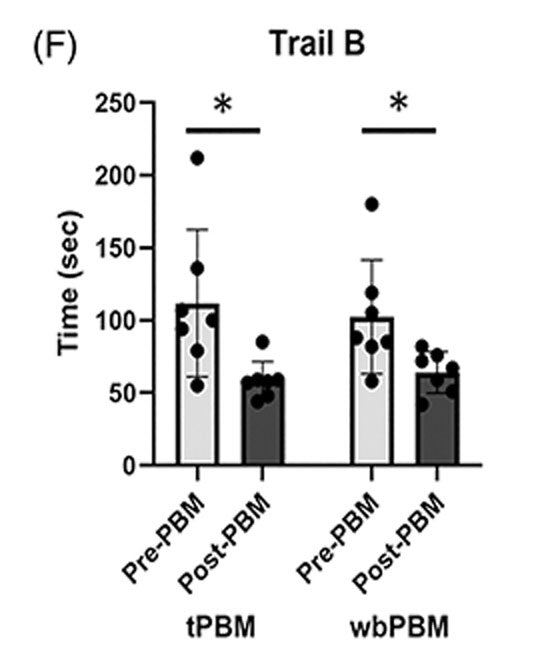
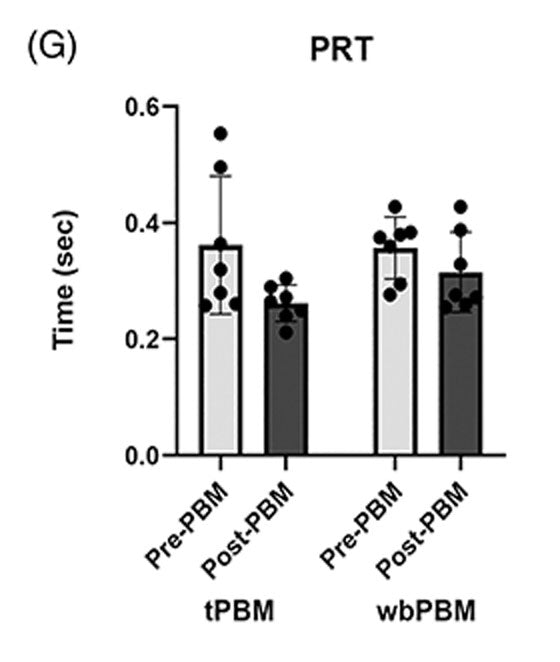
PRT
PRT uses techniques such as pain re-education, somatic tracking, and positive psychology to help individuals change their perception of pain. The ultimate aim of PRT is to retrain the brain to stop generating the sensation of pain, thus reducing the intensity and frequency of chronic pain symptoms.
Traumatic Brain Injury Recovery
We're here for you.
If you want to explore our light therapy device, as well as our 3-month consultation service, please click below.
Discover our device